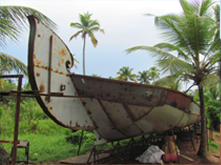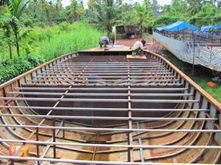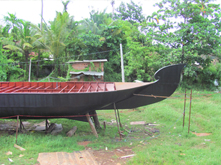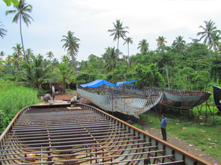


Kerala Houseboat Building

Houseboats are originally called Kettuvallams(Kettu means knot and vallam means boat).These are huge wooden boats with the hull being made by wooden planks tied together by coir and coconut fibre) and coated with sardines' or cashewnut oil. The wood used is mainly matured wild jackfruit tree known as Anjili(Artocarpus hirsutus Lam. - MORACEAE) by the experts. The roof is made of bamboo poles and palm leaves.
Showcasing a unique heritage the Kettuvallams (houseboats) of Kerala are giant country crafts, measuring up to 120 feet in length. It took great skill and craftsmanship to construct these giants without the use of a single nail.
The hull is a series of wooden planks, long cut and carved, tied together using coir with coconut fibers stuffed in between.[5] The hull which is made of hundreds of fine but heavy-duty planks of jack-wood is held together absolutely by coir knots (not a single nail is used). This framework is then coated with a caustic black resin extracted from boiled cashew kernels. And it lasts for generations.[6] The Kettuvallam is motorised and is steered in deep waters by means of oars. Long bamboo poles or 'punts' are used to propel in shallow areas. Bamboo beams sprouting off on the sides are used as foot holds for the same. Bamboo is used for the framework of the roof and splits of bamboo are used for weaving mat for roofing.
Basically the Kettuvallam was designed to transport cargo and as such many design changes had to be made to make it a tourist vehicle. The height of the roof was increased to get sufficient headroom. A plank was laid all through the length to reduce the disadvantages of the curved shape of the hull for walking and comfortable seating. Windows and other openings were provided for light, airflow and view. The entrance is provided in the centre of the linear axis with a top hung panel.
The hull is a series of wooden planks, long cut and carved, tied together using coir with coconut fibers stuffed in between.[5] The hull which is made of hundreds of fine but heavy-duty planks of jack-wood is held together absolutely by coir knots (not a single nail is used). This framework is then coated with a caustic black resin extracted from boiled cashew kernels. And it lasts for generations.[6] The Kettuvallam is motorised and is steered in deep waters by means of oars. Long bamboo poles or 'punts' are used to propel in shallow areas. Bamboo beams sprouting off on the sides are used as foot holds for the same. Bamboo is used for the framework of the roof and splits of bamboo are used for weaving mat for roofing.
Basically the Kettuvallam was designed to transport cargo and as such many design changes had to be made to make it a tourist vehicle. The height of the roof was increased to get sufficient headroom. A plank was laid all through the length to reduce the disadvantages of the curved shape of the hull for walking and comfortable seating. Windows and other openings were provided for light, airflow and view. The entrance is provided in the centre of the linear axis with a top hung panel.
Most of the latest designs have incorporated 3 bedrooms with toilets, a living space and kitchen. There, of course, are variations. Some have a lesser number of bedrooms but with a large living space and maybe a deck balcony at the roof level. Normally, the platforms that cantilever from the hull are used as balconies. Innovative changes have been made to accommodate modern fittings. For fixing the toilet seats, shower tray and ceramic floor finish a concrete slab is laid at the floor level. The soil outlets of the toilet seats are taken through the hull and let out to the flowing water beneath. The use of bio-toilette is common now a days. These toilettes are made of steel cabinets with a network of steel meshes on which beneficial bacteria were grown with the help of a catalyst named actizyme. These bacteria feeds upon human excreta and produces a harmless germ free colourless byproduct. Thus the backwater canals are not polluted. The water for use is stored in a plastic tank kept at the top portion of the main body connecting to the kitchen and toilets. The pipes, tank and other synthetic materials are covered with coir or panambu(thin and split bamboo) to maintain the aesthetic quality of the eco-friendly materials .
Kettuvallam usually has one, two or more bath attached bedrooms, an open lounge, deck, kitchenette and a crew comprising oarsmen, a cook and a local guide. These days houseboats are available upto a maximum of 7 bedrooms with modern amenities.
Floor Plans
The House boats do not have standard floor plans, as each boat is designed to meet the customer's specific needs. The plans shown below represent a sampling of designs built in the past and highlight the concepts and capabilities the company.
All plans are based on a few fundamental principles. These are:
Place the two bathrooms on the centre of the vessel to maintain the balance and tonnage of the boat.
Avoid using a bedroom as the main walkway through the boat.
Provide adequate headroom - both standing and sitting on the bed - in all upper and lower berths.








Modern house boats have been designed to meet the Green Palm/Gold Star Certifications by the Department of Tourism, Government of Kerala, which has recently enacted regulations, stipulating the standards of Kerala houseboats or Kettuvallams.
